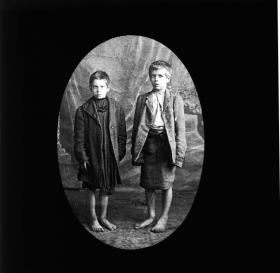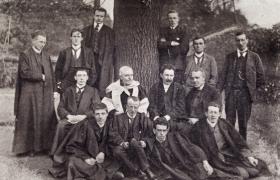Joyce’s looking-glass: the dark side of Irish childhood in creative fiction
Published in 18th-19th Century Social Perspectives, 18th–19th - Century History, Features, Issue 1 (Jan/Feb 2010), Volume 18
Two Dublin street urchins, autumn 1913. Although often recalled with nostalgia, the photographic record is striking for the sheer multitude of children and families living in overcrowded, dirty, squalid conditions.
(Royal Society of Antiquaries of Ireland)
The institutional brutality, neglect and sexual abuse of children catalogued in the Murphy report, and its predessessors, Ryan and Ferns, concentrated on the later twentieth century. But did the Irish not already know of such behaviour in their midst? The truth, as is often the case, has been evident in the works of some of our greatest writers. James Joyce’s Dubliners, a slim volume of fifteen short stories about ordinary people and ordinary lives, is a representative example. Joyce offered his stories as ‘a looking-glass’ in which the Irish could be given ‘one good look at themselves’. Although written with economy of words, a ‘scrupulously mean’ style of prose in which ambiguity is intended to make readers reflect, the allusions to childhood experiences are unmistakably troubling.
Joyce was sensitive to the living conditions of children, their innocence, their suffering and their diseases. Parental attitudes to children are discernible in casual conversation amongst ordinary Dubliners: ‘. . . it’s hard to know what way to bring up children’, declares Old Jack in ‘Ivy Day in the Common Room’. He is puzzled that his teenage son has turned out a disappointment despite a Christian Brothers education and repeated paternal beatings. ‘Only I’m an old man now . . . I’d take the stick to his back and beat him while I could stand over him—as I done many a time before.’ Failing to see that his son’s alcoholism and abusive behaviour may have been learned in the home, he disparages his wife’s softer approach to the children and confidently concludes that ‘. . . that’s what ruins children’.
Paternal violence is also pervasive in the story ‘Eveline’. The nineteen-year-old Eveline contemplates another life, an escape from the continual threat of her father, to whom she gives her entire earnings but has to plead for money to feed the children in her charge and to manage the household. The father who hunts his children with a blackthorn stick has become even more menacing and threatening to Eveline since the death of her mother. The fear she experiences is sufficient to become manifest physically with palpitations.

James Joyce (standing, second from the left) with fellow students at University College Dublin. In Dubliners Joyce was sensitive to the living conditions of children, their innocence, their suffering and their diseases. (National Library of Ireland)
At the conclusion of ‘Counterparts’, Joyce ensures that readers witness the viciousness of childhood physical abuse at the hands of a parent. A terror-stricken young boy is left alone at home to cope with his violent father returning from an evening of drinking after losing his job, pawning his watch and spending all of the money. Victim of the release of his father’s frustrations, the little boy is chased around the dining table with no escape. He squeals in pain as he is caught, beaten vigorously with a walking-stick, and cut on the thigh. Who cannot be moved by this pitiful scene, the innocent child trying to placate his frustrated, drunken father: ‘O, Pa! Don’t beat me, pa! And I’ll . . . I’ll say a Hail Mary for you . . .’?
Corruption of childhood innocence is at the heart of ‘An Encounter’, in which a young boy yearning for real adventure, and believing that this does not happen to people who stay at home, plays truant from school with a friend. During their adventure they notice ordinary social events, such as ragged children playing in the streets, but don’t fully understand all that they witness. Failing to reach their intended destination, they are approached by a pervert, ‘a queer old josser’, who engages them in conversation and speaks with sexual innuendo and reference to corporal punishment. Disliking the man and sensing something sinister and dangerous, they witness him apparently masturbating and becoming more aroused when speaking of whipping young boys than by thoughts of female soft hair and skin.
Joyce is more indirect in his allusions to the influence of priests on children; here, his stories depend on conjecture elicited from the reader. For example, unfinished sentences, insinuations and incomplete conversations about the relationship between a young boy and a fallen priest, Fr Flynn, in ‘The Sisters’ lead to a suspicion that there may have been something not entirely wholesome afoot. At the beginning of the story, Old Cotter offers the following remarks to the boy’s guardians about the recently deceased priest: ‘No, I wouldn’t say he was exactly … but there was something queer … there was something uncanny about him. I’ll tell you my opinion … ’, and ‘I have my own theory about it’, he says, ‘I think it was one of those … peculiar cases … But it’s hard to say … ’. Later he becomes more explicit: ‘I wouldn’t like children of mine … to have too much to say to a man like that’. ‘It’s bad for children’, he declares, ‘because their minds are so impressionable. When children see things like that, you know, it has an effect … ’.
The pervasive influence of clerics and Catholicism on Irish life is one of Joyce’s main political themes, and it is not surprising that a multitude of priests appear or are referred to in Dubliners. It has been remarked that the frequent pairing of priests with children, particularly in the opening stories, suggests some form of affinity, healthy or otherwise, between them. But Joyce’s priests have virtues as well as vices and, like other Dubliners, it seems a fair conclusion that, using the words of Martin Cunningham in ‘Grace’, ‘You get some bad ones and you get some good ones’.
In the century that has elapsed since Joyce’s record of life in Dublin, dysfunctional family life and childhood abuse have been addressed by many observers. Boys and girls are probably still in greater danger of domestic abuse than of abuse by pederasts outside the home. The grim reality of life for many children in Dublin over generations can be readily seen in archival television footage and in anthologies of historic photographs. Although often recalled with nostalgia, the photographic record is striking for the sheer multitude of children and families living in overcrowded, dirty, squalid conditions. Contemporary works of creative fiction, however, notably those of John McGahern (The Dark, The Barracks), Patrick McCabe (The Butcher Boy), Roddy Doyle (Paddy Clarke Ha Ha Ha) and Frank McCourt (Angela’s Ashes), have provided some of the most compelling portraits of the impact of poverty, unemployment and alcoholism on domestic life and childhood experience, as unsettling as those of Joyce, and questioning whether much has changed since Joyce. The collusion of figures of supposed authority, be they the clergy, the police or the professions, in ignoring the impact on the most vulnerable of the intersections of ignorance, depravity, alcoholism and arrogance, as documented by these and other authors, is eerily prescient of what we read today in the Murphy report. HI
Fergus Shanahan and Eamonn Quigley are physicians, professors and amateur Joyceans at University College Cork and Cork University Hospital.
Further reading:
Dublin Archdiocese Commission of Investigation Report (Murphy Report), http://www.dacoi.ie/.
Report of the Commission to inquire into childhood abuse (Ryan Report), www.childabusecommission.ie/.
Report of the Ferns inquiry, www.oneinfour.org/about/fernsreport/.
F. Shanahan and E.M.M. Quigley, ‘Medicine in the age of Ulysses: James Joyce’s portrait of life, medicine, and disease on a Dublin day a century ago’, Perspectives in Biology and Medicine 49 (2006), 276–85.
















